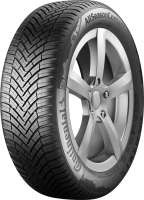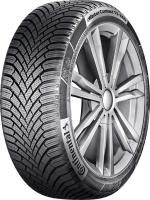6 categories (13 tests)
Fortunately, our friends at Vi Bilagare once again have us covered. During their Nordic winter testing in 2020, the magazine included an all season and "european" winter tire alongside their usual selection of Nordic friction and studded winter tires.
As the all-season and European winter tire were being tested from a Nordic perspective, they had a significant testing on ice, which is a rarity for an all-season tire.
The results... well, I’m sure you can guess how each of the four tire types performed on each surface, but it's really cool to see all this data from one source.
One last thing worth noting, while the all-season and winter tires are named tires, the Nordic winter tire and studded winter tire are an average of the five best tires for each category from their respective full tests, not a single tire pattern we can name.
Ice
Ice is the most extreme surface for winter tires, so it's no surprise that during the ice braking and traction testing on smooth ice, the studded tire held the advantage.
The Nordic winter tire was impressively close to the studded tire during ice braking, stopping the car just 1.1 meters further on, with a larger 3.5 meter gap back to the European winter tire. The all-season tire also had an impressive result considering it's not developed for harsh winters, stopping less than 1 meter longer than the European winter tire.
The order of the tires remained the same for the traction test.
Ice handling was a real surprise, with the Nordic winter tire actually besting the studded tire! This is down to the ice handling testing taking part on rough, not smooth ice, where the softer compound of a Nordic winter tire is better at adapting to the rough surface, and the steering response better than a studded tire.
Snow
Snow testing showed a similar pattern to ice, just with slightly bigger gaps between the different types of tires.
The Nordic and studded winter tires were very close during the snow braking testing, with the all season tire falling further behind the European winter tire than during the ice testing.
This pattern was again replicated during snow traction testing, but this time the studded winter tire had a slight advantage over the Nordic winter tire.
Snow handling had the all-season tire fall significantly behind the european winter tire.
Wet
While the all season tire struggled in snow and ice, the results were reversed during wet testing.
Like in previous testing, there was larger gap between the more extreme winter tires and the European winter tire, than the European winter tire and the all-season tire, with the Continental AllSeasonContact and WinterContact TS860 performing vastly better during wet braking.
This trend continued to wet handling.
Aquaplaning was also very close between the two milder climate tires, with the snow and ice specialists struggling to clear standing water.
Dry
As in the wet, the more extreme the tire, the more it struggled in the dry, with a large gap between the all-season and studded tires during the dry braking testing.
Environment
The gaps in rolling resistance weren’t huge, which was impressive for a studded tire.
Naturally, the studded tire was significantly nosier than any of the other tires, with the softer compound of the Nordic winter tire producing the lowest noise.
Results
1st: Continental AllSeasonContact | |||||||||||||||||||||||||||||||||||||||||||||||||||||||||||||||||||||||||||||||||||||

|
| ||||||||||||||||||||||||||||||||||||||||||||||||||||||||||||||||||||||||||||||||||||
1st: Continental WinterContact TS 860 | |||||||||||||||||||||||||||||||||||||||||||||||||||||||||||||||||||||||||||||||||||||

|
| ||||||||||||||||||||||||||||||||||||||||||||||||||||||||||||||||||||||||||||||||||||








